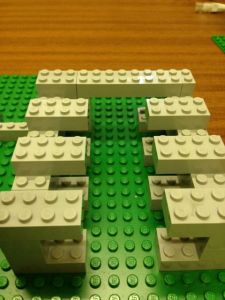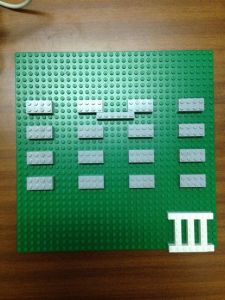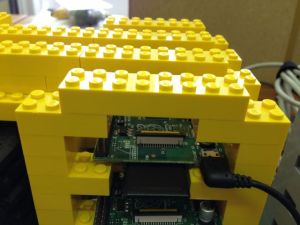A few people requested that we describe the design of our racks.
The truth is, each rack is slightly different and the final build is not the one we’d planned. A couple of reasons for this: we didn’t quite receive the Lego pieces we were expecting, and we had to tweak the designs to make things fit better. So this is a somewhat retrospective design document…
We have four racks containing 14 Raspberry Pi’s each, actually composed of two adjacent towers. In between the towers are two USB hubs. The design is such that the front provides access to the SD card slot and micro-USB power supply, so we can easily change SD cards and reset the Pi’s. We can also slide the Pi’s out, which is incredibly useful as we tend to be cannibalising Pi’s quite often, or else swapping them around for testing. The back of the racks has space to reach the ethernet port, and each rack has a dedicated Netgear GS116E switch.
Each rack sits on a green 32 by 32 stud (25cm x 25cm) Lego baseplate.
Ten studs worth of space is left in front of the rack, and eight studs at the back. There’s a gap of two studs either side of the rack.
For the most part, the towers follow four simple layers of Lego, corresponding to a snug fit for a single Raspberry Pi. The only exceptions to these layers are (a) connecting structs between the two towers to hold them together and (b) the top of the racks, which are frankly all of differing design depending on the academic or student that built them! Particularly as the available Lego ran out, the designs became more improvised. So here I’ll just show the three layers that make up the towers and a few examples of the improvisations people chose.
For the first layer, we use 2×4 Lego bricks to create “feet” that protrude into the space for the Pi. The Pi actually sits on these feet, to give it space below for the SD card and to allow airflow underneath the Pi’s (the extra piece in the centre is to keep the USB hub in place):
Next, we simply add two layers of Lego that do not overlap the feet, just building the perimeter wall with enough room for the Pi:
Here’s a few horizontal shots to clarify:
The fourth layer is more or less the same as the first layer, but we add a long strut at the back instead of the two 2×4 lego pieces we had, to strengthen the structure:
shots from the side and the back:


Now we simply repeat the second, third and fourth layers on top of this, until we eventually have enough room for seven Pi’s in each tower. Just a couple of exceptions:
Struts are added an intervals in the rack to strengthen the towers. For example, see the one halfway up the red tower in the image below:
The tops of the racks are a little improvised. Here’s one example:




















